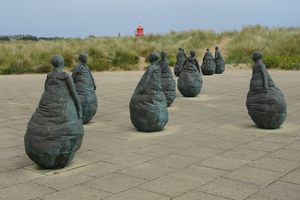About
A blue and white building known locally as the Watch House stands along the mouth of the River Tyne. Step inside, and you’ll find a collection of artifacts belonging to the world’s first volunteer life brigade, which was founded after a maritime tragedy.
In 1864, there were only four men responsible for coast guard duties at the entrance to the River Tyne, and two of these men were of pensionable age. But this would all change on the night of November 24, 1864.
Then, a fierce storm sprang up from the southeast. Two vessels, the schooner Friendship and the passenger steamer Stanley, were caught in a fierce gale. Friendship attempted to find shelter at the entrance to the Tyne but was driven aground onto a treacherous stretch of rocks called the Black Middens. The crew drowned because of a breakdown in communication between the coastguard and lifeboat rescue teams.
Some hours later, with darkness falling, the captain of the Stanley also attempted to find shelter by entering the Tyne during the height of the storm. A huge wave thrust his vessel onto the Black Middens, splitting it into two. Attempts to approach the stricken vessel using the local lifeboat were in vain and the lifeboat itself was swamped by waves. The coastguard fired a breeches buoy, which is a rocket attached to a rescue line over the decks of the Stanley, but it was caught in the rigging.
As the storm abated, the full disaster became clear. Thirty-two crew and passengers from both vessels had drowned, in full view of crowds watching on the river banks powerless to help.
A meeting was held at the local town hall shortly after the tragic event. It was realized that had there been a company of well-organized, disciplined men available immediately, then more lives would surely have been saved. The Tynemouth Volunteer Life Brigade (TVLB) was thus founded, with over 100 men signing up that day.
The TVLB has saved countless hundreds of lives since its founding and is still operational today, working in conjunction with the modern local coastguard on what can be a very unpredictable stretch of coastline. The Watch House Museum contains the relics of many ships that have run aground. You’ll find items like ship nameplates, early wooden figureheads, and some more unusual items such as a ship’s clock which has stopped at the moment the ship ran aground in the storm. Visitors can also see the breeches buoy equipment used to rescue passengers and crew from ships in distress. The second floor has panoramic windows, which look out onto river where countless ships have met their end.
Related Tags
Know Before You Go
The museum is free, though donations are gladly accepted. Opening hours are limited. Ring the bell and a lady will come from one of the cottages behind the watchhouse, let you in, and answer any questions you might have. You are free to roam around the museum at your leisure and look at the treasure trove of artifacts that are there. Or, you can contact the brigade secretary to arrange a group tour.
Community Contributors
Added By
Published
September 24, 2018


































